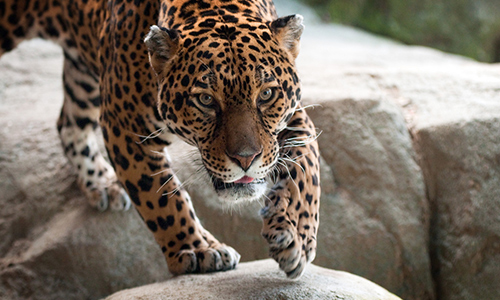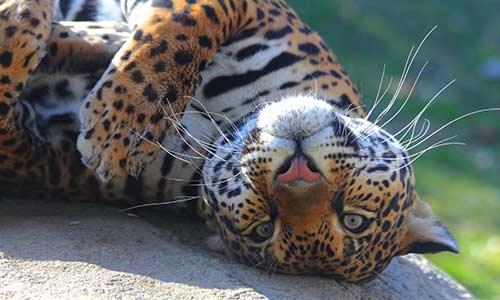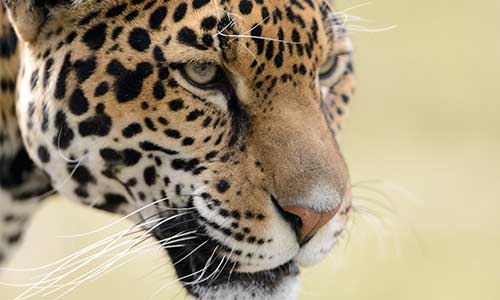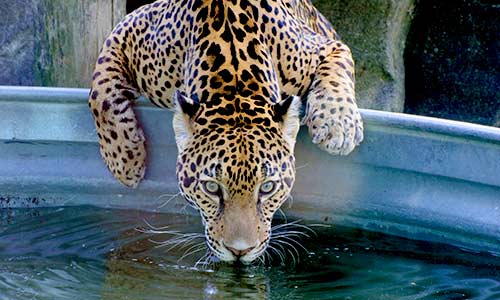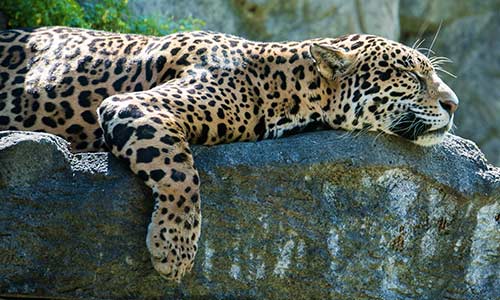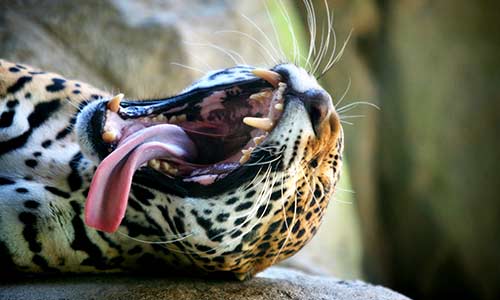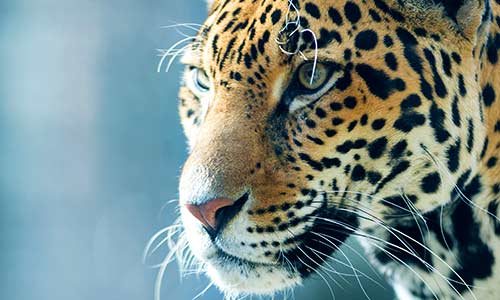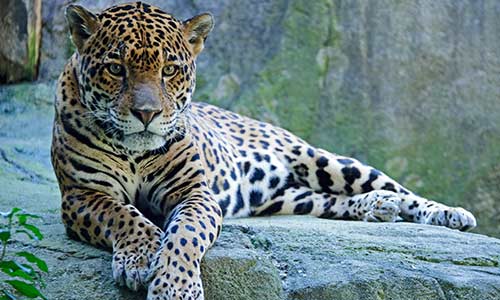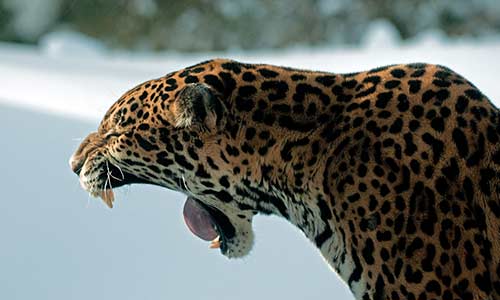Jaguar
Panthera onca
About the Jaguar
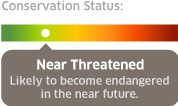
Geographic Range:

Class: Mammalia
Order: Carnivora
Family: Felidae
Genus: Panthera
Species: onca
The third largest “big cat” after the lion and tiger, the jaguar has a stocky build, short legs and a broad head. The jaguar’s tawny fur has black rosettes that are more fragmented than the leopard’s and encircle small spots. The jaguar is an elusive, solitary animal whose markings provide excellent camouflage in its forest habitat. The name jaguar derives from the Guarani Indian word yaguara, which means “the beast that kills with one leap.”
Committed to Conservation
Northern Jaguar Project
We support the Northern Jaguar Project, whose innovative work is mitigating conflict with ranchers and protecting jaguars across a wide swath of northern Mexico.
AZA SAFE: Saving Animals from Extinction
We're proud to support the Association of Zoos and Aquariums' SAFE initiative: A commitment to harness our collective resources, focus on specific endangered species, and save them from extinction by restoring healthy populations in the wild. Since the mid-1980s, AZA member institutions have funded, conducted and supported jaguar-related fieldwork in Central and South America. Using objectives outlined by the IUCN Species Survival Commission Cat Specialist Group, the SAFE jaguar program is focused on protecting jaguars primarily in Central America, and expanding capacity to protect jaguars throughout their range.
Species Survival Program
Zoo New England participates in the jaguar Species Survival Plan. By sharing research and knowledge, participating institutions work together to establish guidelines that best ensure the health of captive populations, and with success, the survival of endangered species.
Jaguar Facts
Appearance:
Jaguars have a stocky build, with short legs and broad heads. They have the most powerful jaws of all the big cats, and they’re also the only cat species that kills by crushing the skulls of their prey. They can even bite through turtle shells! Their tawny fur has black rosettes (rose-shaped and more fragmented then those of leopards) encircling small spots. These markings provide excellent camouflage. “Black” jaguars are common, and as with other melanistic (dark-colored) cats, their spot patterns are visible. The ends of their tails are striped, and their night vision is six times more acute than human’s under poor illumination.
Size:
Forest jaguars tend to be smaller than their open country counterparts.
Head and body lengths: 44 – 75 inches; tail length: 13 – 32 inches.
Height at shoulder: 27 to 30 inches
Male: 125 – 320 pounds
Female: 75 – 220 pounds
Diet:
Jaguar diets differ between rainforest and open country, likely due to the lack of large concentrated game in tropical forests. Almost any species that these cats can catch will be eaten. This includes birds, fish, mammals, reptiles and carrion (decaying flesh of animals). Large prey such as peccaries, tapir, capybaras, deer and cattle are their preferred species. With large prey, jaguars will consume what they can and then cover the carcass with debris so they can return to it later.
Reproduction:
Females reach sexual maturity between 2 and 3 years; males mature between 3 and 4 years. Gestation lasts from 91 to 110 days, and females can deliver up to four cubs, two on average. Unlike other feline species, male jaguars may stay on to help raise their young.
Behavior:
Jaguars are elusive, solitary and primarily nocturnal, though they’re known to travel by day. Jaguars love the water, and they’re good swimmers. They can climb trees, though their stocky build makes them less agile than "Old World" leopards found in Africa and Asia. Though they mostly hunt on the ground, jaguars will sometimes climb trees and pounce on their prey from above. Like other big cats, jaguars mark their territory through tree scrapes and urine.
Habitat/Range:
Jaguars are only found near water sources and prefer dense tropical forest, lowland forests, swampy grasslands and deciduous mountain forests up to 8,000 feet in altitude. They cover a territory of up to 220 square miles and may travel up to 500 miles.
Today, jaguars range from northern Argentina to Mexico, but historically they’ve been found as far north as Arizona, New Mexico and Texas, and as far south as the tip of South America.
Life Expectancy:
Average 17 years
Threats in the Wild:
Jaguars are the top predators in their range; humans are their only threat. Habitat fragmentation and loss, human encroachment and the fur trade are the main causes for their decline. Though legally protected in most of their range, hunting is permitted in Brazil, Costa Rica, Guatemala, Mexico and Peru, where jaguars prey on domestic animals. Trophy hunting is permitted in Bolivia.
Status Note:
The elusive nature of the jaguar and impenetrability of their dense forest habitat make studies in the wild and number estimation difficult.
Fun Facts:
- Is it a jaguar or a leopard? The difference lies in their spots. Unlike leopards, jaguars have spots inside their spots (also called rosettes)!
- Central and South American mythology abounds with jaguar stories and legends. The art and culture of the Huichol, Olmecs, Maya and Aztecs depict the beauty and power of the jaguar.
- The word jaguar comes from the Guarani Indian word, "yaguara," meaning “the beast that kills with one leap.”
The jaguar needs to stay indoors and off exhibit if it's below 32 degrees. Visit our Winter Visits page to learn more about the amazing animals you can see during the winter!
You Can Find This Animal in the Treasures of the Sierra Madre
Spot the difference
Is it a jaguar or a leopard? The difference lies in their spots. Unlike leopards, jaguar have spots inside their spots (also called rosettes).
You May Also Like
At Franklin Park Zoo:
At Stone Zoo:

